NEW SCALE-CHANGING: ARTIFICIAL INTELLIGENCE
Artificial intelligence technologies, while frequently discussed, have evolved beyond merely representing a technology; they have introduced a new dimension, scale, and a distinctly “new direction” different from previous methods. Amid the countless necessary and unnecessary debates ongoing in this field, we must not neglect to advance and refine our own methods. Such neglect will lead to irreversible consequences for both companies and societies. Despite being in its nascent stage, the measurable market for artificial intelligence tells us a lot. In my personal prediction, the developments in the coming years will surpass all research forecasts and expectations. However, it is also crucial to eliminate works that lack depth, offer no new contributions, and are merely labels. Now, let us revisit our journey from the beginning to the present around significant figures and confront the reality we face. Because we are facing a new reality without “ifs,” “buts,” or “howevers”—artificial intelligence has the power to transform the entire system, sectors, and culture we have built so far.
In these times when confronting the reality of artificial intelligence technology has become essential to staying in the game, one of the fastest ways to face this technology is by confronting the size of the market.
Image 1:
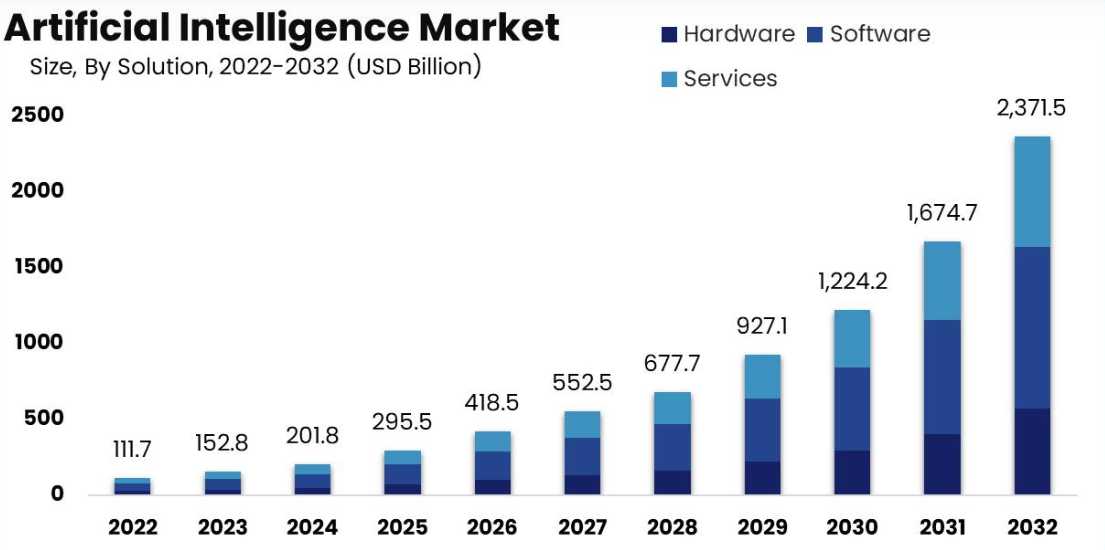
Source: https://marketresearch.biz/report/artificial-intelligence-market/
According to a study published in March 2023, the global artificial intelligence market, which was valued at $111.7 billion in 2022, is projected to reach $2,371.5 billion by 2032.
Image 2:
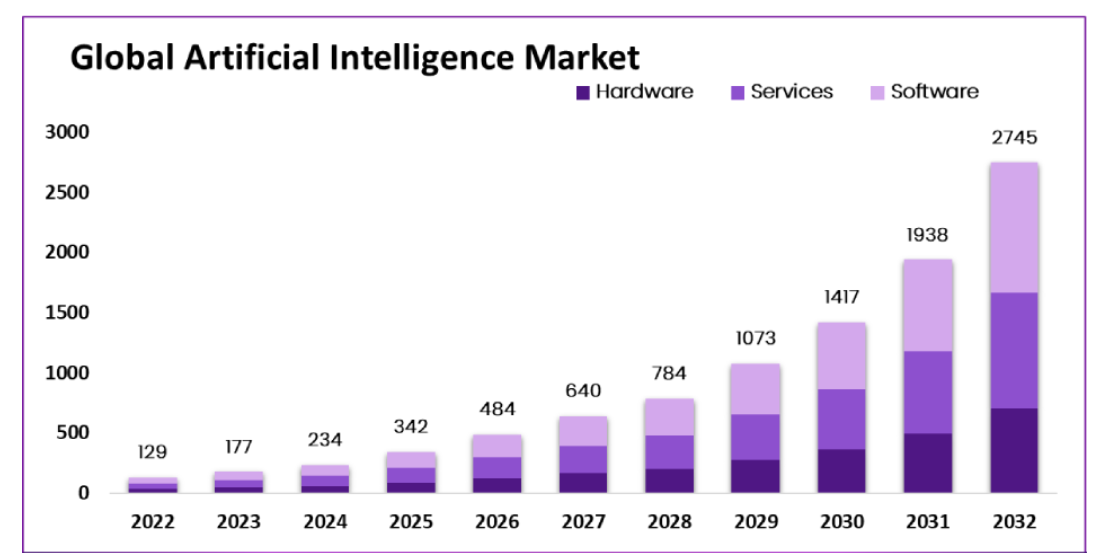
Source : https://market.us/report/artificial-intelligence-market/
According to a study published in January 2024, the global artificial intelligence market is expected to grow from $129 billion in 2022 to $2,745 billion by 2032.
Image 3:
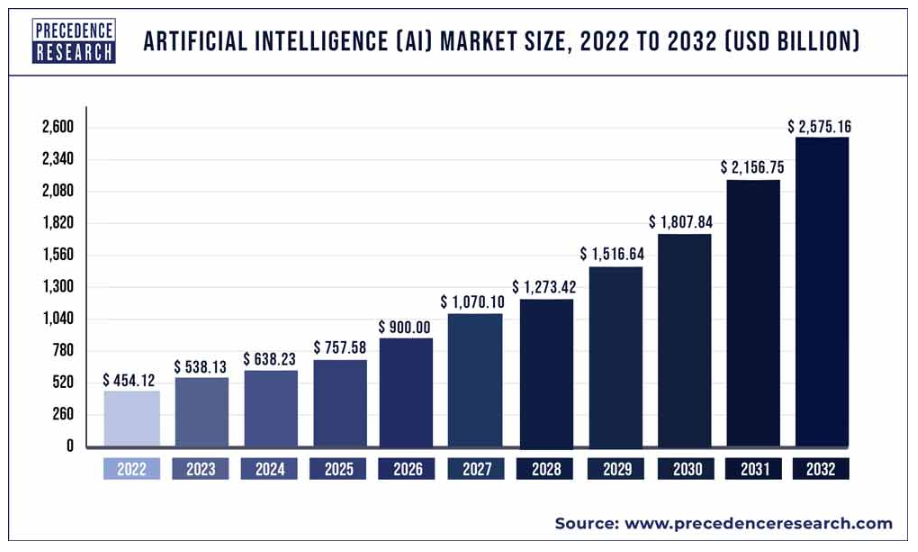
Source: https://www.precedenceresearch.com/artificial-intelligence-market
According to another study published in October 2023, the global artificial intelligence market was valued at $454.12 billion in 2022 and is projected to reach $2,575.16 billion by 2032. According to this study, in 2022, 23.38% of the revenue in the global AI market came from hardware, 36.98% from software, and 39.64% from services.
Image 4:
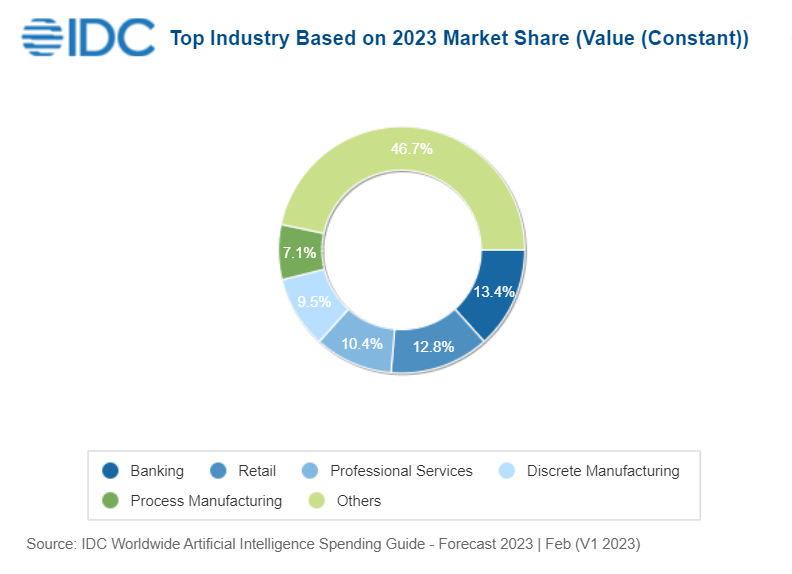
According to a study published by IDC, the sectors expected to make the most artificial intelligence investments in 2023 are banking, retail, and professional services. The study indicates that global spending on AI-centric systems was $154 billion in 2023, and this figure is projected to exceed $300 billion by 2026.
Image 5:
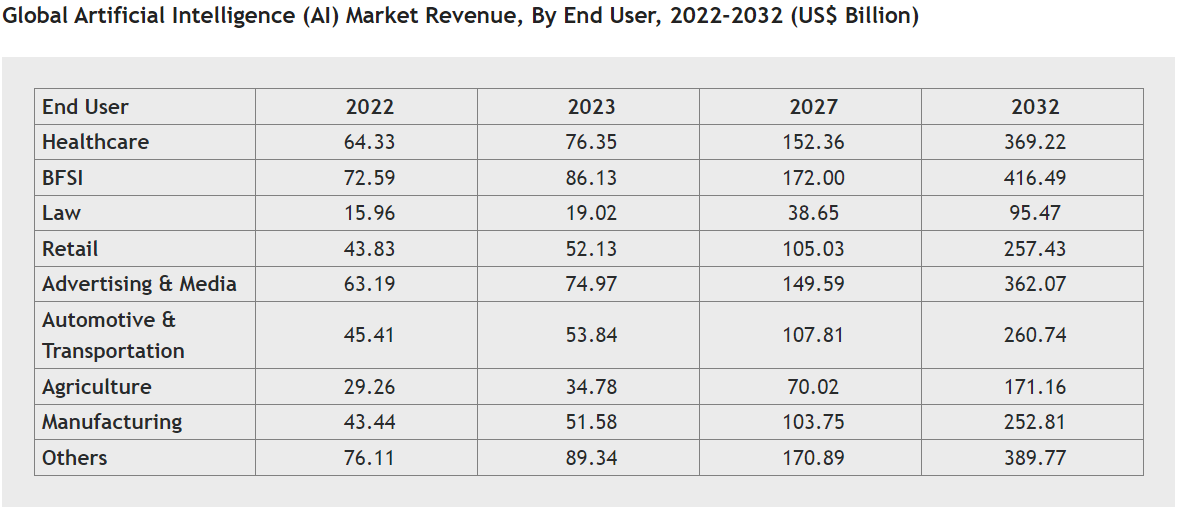
Source: https://www.precedenceresearch.com/artificial-intelligence-market
Studies examining the potential impact areas of artificial intelligence seem to enumerate all sectors contributing value to the global economy from A to Z in a single breath. As noted in Visual 5, when evaluated in terms of revenues from end users, sectors such as healthcare, finance, media, advertising, retail, automotive, transportation, and manufacturing emerge as prominent in this process.
While data on the development of the AI market is quite clear, AI technology is a highly advanced field requiring significant know-how and high costs.
Even for small models, GPU costs range from $700 to $1,500. Larger models like GPT-2 require multiple high-end GPUs and other hardware like AI accelerators. The unit cost of GPUs suitable for this level ranges between $10,000 and $20,000. [1]
Compared to GPUs, FPGAs offer lower costs but come with more challenging programming requirements. Basic FPGAs can be accessed at around $5, but advanced FPGAs needed for high-level applications can exceed $10,000. [2]
In addition to high hardware costs, AI users who prefer to use their own hardware also incur annual electricity and maintenance costs of approximately $2,000 to $5,000. [3]
According to a publicly released study, the server infrastructure and operational costs in the “Generative AI Data Center” field are projected to exceed $76 billion by 2028. [4]
The total cost of AI technology includes various parameters such as hardware and infrastructure costs, as well as high employee, data collection, and storage costs.
Even for technologies that can be developed at relatively low costs, maintaining continuous R&D investments and progressing with great discipline has proven to be a significant challenge. In the realm of AI technology, this challenge reaches a much more complex dimension.
Discussing the importance of AI technology in terms of economic and technological capabilities may seem like repeating what is already known, but the substantial investments required by the technology can obscure this known fact or cause it to be perceived solely through the lens of technology giants. The biggest mistake in this process begins precisely at this point.
It is clear that conducting R&D investments in AI technology requires enormous resources. However, viewing the contributions of technology giants with strong financial resources and years of data collection efforts as the only possible centers of the AI ecosystem is an extremely myopic stance. If we only focus on news such as Google’s DeepMind AlphaGo system requiring 1,920 CPUs and 280 GPUs or OpenAI accessing billions of dollars in funding, we risk merely admiring the size of technology giants rather than understanding the broader picture. [5]
While the management issues of these billion-dollar organizations or the costs of making their seemingly boundless big data meaningful can be examined, if the goal is to build a strategy for success in the target sector, reducing success to the challenges faced by major competitors would reflect an insecure and misleading perspective.
Firstly, it should be recognized that leveraging AI algorithms does not require having data power equivalent to a global search engine or a service provider shaping the e-retail sector. Even relatively limited data, collected or produced around a specific purpose, can be sufficient for many vertical product developments. This reality should guide actions in this field.
Those who embrace this reality and escape the “we’re already going to lose” mindset face a real challenge: computing power. For innovative researchers who need similar capabilities to their counterparts generating value for global players with six-figure salaries, the fundamental issue is the requirement for computing power. Expecting researchers to secure or organize funding for this resource will not enable sustainable development.
Opening up the computing power required for AI based on a cloud-based shared resources approach will facilitate effective resource management according to the “shared resources” principle. This process will enhance the accessibility of AI technology by spreading technological development more broadly.
For this process to deliver the promised value, it requires comprehensive planning focused on using infrastructure as efficiently as possible. Without this, thousands of dollars’ worth of infrastructure will merely serve as “technology centers” that become exhibition and foyer areas, and regional elites will continue to form new ones.
Unless we can facilitate the correct alignment of resources with the right actors, we will remain bound to marveling at the impressive economic outputs of the AI market, admiring the successes of technology giants and other global elites, and being users of technologies shaped by the ethical values of these global elites.
The profound difference between the existence and absence of AI technology demands urgent and planned efforts aligned with this new reality. We will observe the deep divide between winners and followers within a few years. Which group we belong to will be determined by what we do in this regard.
Source: Ölçekleri Değiştiren Yeni: Yapay Zeka – SavunmaTR

